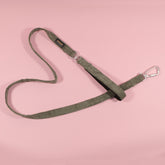Why is obedience training important for dog and owner?
How obedience training affects the relationship between the dog and the owner
Obedience training is crucial for the dog and its owner. It has a positive impact on the relationship between them because it allows for better understanding and mutual trust. Thanks to obedience training, the dog is able to respond better to the owner's commands, which translates into better communication between them. Without a doubt, you will be more willing to go for a walk with your dog when it obeys your commands and walks calmly on a leash.
Obedience training and dog safety: how to avoid dangerous situations
It is also important for the dog's safety. A dog that is well trained is less likely to run away and is easier to control in various situations, which reduces the risk of dangerous incidents. Crossing the road when your dog knows a command, e.g. "stop", seems much more comfortable for the owner.
Obedience training as a way to improve dog behavior
A dog that is well trained is less likely to behave aggressively and has better control over its behavior, which translates into a better quality of life for the dog and its owner. Quietly walking past a neighbor's barking dog or a neighbor with a cat on his shoulder is a comfort that many people envy to other pet owners.
Obedience training and the dog's mental and physical health
A dog that is well trained is more relaxed and in a better mood, which translates into better well-being and health. Training for a dog is a type of activity comparable to a person's visit to the gym or fitness club. Running, jumping, fetching and carrying out commands is a lot of effort for dogs. Even a leisurely walk can be exhausting, provided the distance covered is long enough.
Obedience training as a way to better use the dog's potential
Finally, obedience training is an effective way to better utilize your dog's potential. A dog that is well trained is more motivated to work and has more opportunities to develop its skills, which translates into better use of its potential. Remember that intellectual effort while practicing commands can be as exhausting as aimless running, e.g. in a meadow.

Obedience training - what exercises are worth doing with your dog
Basic obedience commands: where to start?
The most important obedience commands for a dog are: "sit", "down", "down", "come", "leave it" and "give your paw". These commands allow for basic dog control and make everyday life with your dog easier. Of course, you can use any other words, although it is recommended that they be relatively short and different from each other. It will be easier for the dog to learn the "sit" command than "put your four letters on the ground".
To teach your dog these commands, first of all, start by introducing the dog to new words and gestures that will mean a specific action.
Introducing your dog to new words and gestures may be easier if your dog is young and not yet used to other commands. This can be done through a few simple steps:
- Select the command you want to teach your dog, e.g. "sit" or "give your paw".
- Repeat the command verbally, loudly and clearly, e.g. "sit" or "give your paw".
- After a few repetitions of the verbal command, introduce a gesture that will indicate this command, e.g. pointing to the ground with the "sit" command or holding an object in front of the dog with the "give paw" command.
- When your dog responds to a verbal command and/or gesture, reward him with a treat or praise.
- Repeat the exercise several times a day until the dog responds to verbal commands and gestures without the need for rewards.
Training methods for an adult dog may be slightly different than those used with a young dog.

Since an adult dog may already have some habits and behavior patterns encoded, it is worth remembering that its training will be slightly different than in the case of a puppy. Here are some tips for training an adult dog:
- Continue training: If your dog has mastered basic commands, it is still a good idea to continue training him to keep his skills up to par.
- Introduce new commands gradually: an adult dog may have difficulty learning new commands, so it is worth introducing them gradually, repeating them several times a day.
- Use positive reinforcement: reward for following commands with a favorite treat, toy or praise that the dog recognizes.
- Adjust the pace to the dog: an adult dog may be less agile than a young dog, so you need to adjust the pace and type of commands to its capabilities. Trying to teach an older dog to jump or spin may not be the best idea. Just as people age, there is a greater risk of injuries such as muscle tears, dislocations or even fractures.
- Use different methods: An adult dog may respond to different training methods, such as clicking, positive opposition, or play training.
- Be patient: adult dogs may take longer to learn new commands, so you need to be patient and consistent with training.
It is important to remember that each dog is different and depending on the situation may require more time and work to master a particular exercise.
Use positive reinforcement methods
Another important aspect is the use of positive reinforcement methods, such as rewarding the dog for good behavior and ignoring undesirable behavior. Remember that a dog learns by association*, so rewarding him for good behavior will help him remember what behavior is desired.
* Association is the process of combining two or more stimuli into one concept or relationship. It may be a combination of sound and image, smell and taste, or a situation with emotions. Association is important in the learning process because it allows you to combine new information with existing knowledge, which facilitates the acquisition of new information. In behaviorism, association is important in the animal training process because it allows for combining commands with appropriate behavior. For example, if a dog is trained to associate the command "sit" with a sitting position, then after a while it will automatically sit when it hears this command.
Be patient and exercise with your pet regularly
Finally, it is also important to exercise your dog regularly to keep his skills sharp and develop them further. Remember that obedience training is a long-term process, but through systematic and patient action, you will be able to enjoy having an obedient and content dog. He, however, will be happier to follow your instructions. Mutual understanding will bring you even closer to each other.





















